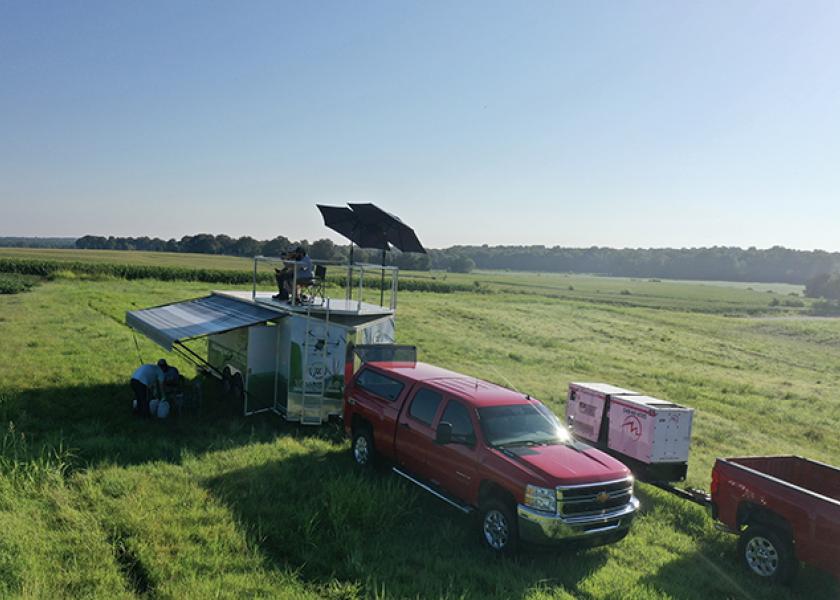Ag Retailer Fills Need and Finds Niche with Drone Spraying

Almost one year ago, the team at Henry Farmer’s Co-op had their certifications and received their first drones to for spray applications.
Now, Cody Ray, precision ag sales at the co-op, shares the team has overcame the learning curve, mastered an efficient process and bobbed and weaved with the challenges of this growing season.
In all, this past year Ray and the team of two pilots and two dedicated observers have applied more than 5,000 acres.
He says the need has been realized over time as it’s been more difficult to secure contracts with aerial applicators for the full time and acres needed during the high-demand fungicide application window. So Henry Farmers Co-op signed on with the team at Rantizo to help with the certification process and three DJI Agras T30 drones.
Here’s the first curveball they had.
Only two of the three drones were fully ready to fly in 2022 because of the parts availability. However, Ray and the team were quickly grateful for having the out of service drone allowed for it be used for any needed spare parts that couldn’t otherwise be sourced.

Here’s the second curveball.
The 2022 application season actually started earlier than they were expecting. While they did some test acres in the previous fall, they weren’t expecting to be fully spraying until well into the growing season. However, with the wet spring, they got a lot of acres under them with applications early in the season particularly in wet fields that weren’t fit for ground rigs.
The early practice and the team’s adaptability helped them refine their process, and gain efficiency.
Each application job has the four-man team on-site. The two pilots and two visual observers coordinate with every refill, tank mix, and every battery charge so it maximizes the time for the drone to be applying, refilled and then redeployed to the field.
It’s been a challenge the team has put to themselves to trim time on the process.
“If we cut 20 seconds on every fill, and we do 50 fill ups in a day— we save 25 minutes,” Ray says. “That could be another 10 acres a day.”
The team outfitted a trailer with 500 gal of water, and a gas-style nozzle to refill fast. The team started with three generators to charge the batteries, but they were pulling so much power, they burnt up. Instead, now they use a diesel powered generator that will charge a battery in 10 minutes.
“Running two drones with no issues, we can do 200 to 250 acres a day,” Ray says.
Rantizo says most of its applicators are able to apply about 20 acres/hour. The team at Henry Farmers just takes it to the next level.
“Really, the only thing that slowed us down is the heat as crop conditions prevented having the ideal timing to apply,” Ray says.
So why drones? Where do they fit?
In recent years, Henry Farmers has contracted with helicopter and airplane based applicators to apply 20,000 to 30,000 acres. Ray says those applications don’t generate service-based revenue for Henry Farmers, and it’s been difficult to secure professional applicators for the entire time needed.
So they are taking a bit more control over their own plan. In the past year Henry Farmers also added its first high clearance applicator to the fleet—a Hagie.
“Anything we can do to generate that service and not be dependent on a contractor, is a good opportunity for us,” Ray says.
Ray notes drone applications are not to replace the ground rigs but rather supplement application opportunities the ground rigs can’t do or aren’t the best tool.
“We bought the Hagie to spray the big acres and then we can jump around with the drones and cover the little corners where the Hagie would run over too much,” he says as an example. “The drones may not look that efficient just by themselves, but when you add their capability, it means we can focus the Hagie where it can go faster and be more efficient as well.”
When and Where Applications: The Rise of the Sprayer Drone
Surprises along the way.
An advantage of the drone spraying is farmers can come to the field edge and talk to the team during the application—which isn’t possible with traditional aerial applications.
“We’ve had farmers say they like the interaction with an applicator,” Ray says.
Ray also describes his role, which is keeping the drone pilots flying and the drones applying. He does all of the bidding, mapping, legal paperwork, and billing.
The co-op’s main office is in Paris, TN with other locations in Cottage Grove, TN and Murray, Ken. Most of the farmers in the service area are growing corn, soybeans, and wheat along with some tobacco and canola.
While fungicide application was the No. 1 market the team aimed to service with the drone sprayers, the widespread dry conditions in 2022 across their service area have brought a lower fungicide application market than expected.
Ray reports the team pivoted and have been engaging with recreational landowners, especially duck hunters, who need wet lands sprayed or are interested in seeding food plots.
Ray has been at the co-op for eight years, and he has enjoyed the challenge of being the point person to find the new technology the team should be bringing to farmers.
Boiled down he says, “it’s all about figuring out ways to be more efficient. We want to be on the leading edge. Otherwise, we’d be left behind. And then it’s just a catchup game.”







